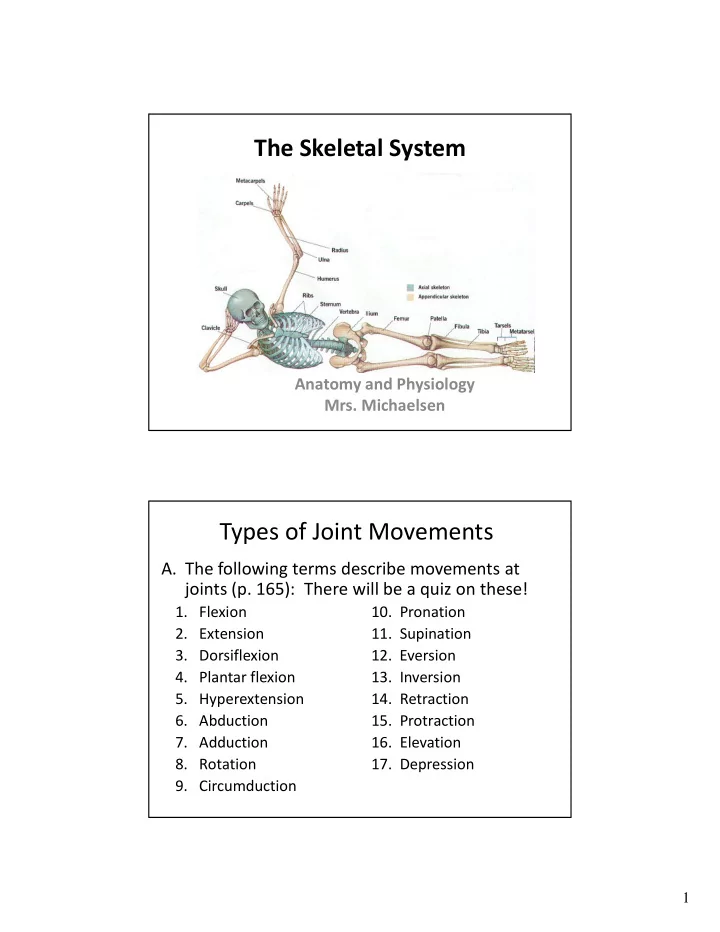

The Skeletal System Anatomy and Physiology Mrs. Michaelsen Types of Joint Movements A. The following terms describe movements at joints (p. 165): There will be a quiz on these! 1. Flexion 10. Pronation 2. Extension 11. Supination 3. Dorsiflexion 12. Eversion 4. Plantar flexion 13. Inversion 5. Hyperextension 14. Retraction 6. Abduction 15. Protraction 7. Adduction 16. Elevation 8. Rotation 17. Depression 9. Circumduction 1
2
7.1 Introduction A. Bone is an B. Composed of: 1. 3
7.1 Introduction (and 7.4 Bone Function) A. B. Protects 1. C. Helps make 1. D. Hematopoiesis or 1. Begins in E. Passageway for 4
7.1 Introduction (and 7.4 Bone Function) A. Stores 1. Bone stores 2. Blood calcium is low, stimulates osteoclasts to 3. Blood calcium is high, and osteoblasts 4. Calcium is needed for 5
7.2 Bone Structure A. Long: B. Short: C. Flat: D. Irregular: E. Sesamoid (round): 7.2 Bone Structure A. Parts of a Long Bone 1. Epiphyses or ends of the bone; 2. Articular cartilage: 3. Diaphysis: 4. Medullary cavity: 5. Endosteum: 6. Periosteum: 6
7.2 Bone Structure A. Microscopic Structure 1. Spongy a. Also called b. Texture results from needlelike threads of bone called c. Found in d. Spaces contain 7
2. Compact a. Structural unit is an 8
7.3 Bone Development and Growth A. Intramembranous Bones 1. Broad, 2. Form by replacing 3. Osteoblasts become 4. Once completely surrounded by 5. The periosteum develops and Bone remodeling video 9
7.3 Bone Development and Growth B. Endochondral Bones 1. Most bones 2. Formed from hyaline cartilage 3. Primary ossification begins in 4. Epiphyseal plate (metaphysis) remains 5. Epiphyseal plates are 6. Long bones thicken as compact bone is formed 10
Bone Growth and Development Epiphyseal Plate Epiphyseal Plate 11
7.3 Bone Development and Growth C. Homeostasis of Bone Tissue 1. is exchanged each year. 2. Osteoclasts break down 3. Osteoblasts invade the region and 4. This occurs through life and 7.3 Bone Development and Growth D. A number of factors influence bone development, growth, and repair. 1. Vitamin D is necessary for a. Without it the matrix of bone lacks 2. Growth hormone secreted by the anterior pituitary stimulates 3. Sex hormones stimulate 4. Physical exercise stimulates bone to 12
VI. Divisions of the Skeleton A. Skeleton composed of the following divisions and subdivisions: 1. Axial skeleton a. b. c. d. 2. Appendicular skeleton a. b. 13
VII. Differences Between a Man’s and Woman’s Skeleton A. Size: Male skeleton B. Shape of pelvis: C. Size of pelvic inlet: Female pelvic inlet generally D. Pubic angle: Angle between pubic bones of Female and Male Pelvis 14
15
VIII. Joints (Articulations) A. Kinds of Joints 1. Functional 2. Classified by a. b. c. B. Fibrous Joints 1. Between bones that 2. C. Cartilaginous Joints 1. 2. Synarthroses 16
Amphiarthroses D. Synovial Joints 1. 2. Structures of freely moveable joints – a. Articular cartilage: Covers joint b. Synovial membrane: Lines joint c. Joint cavity space between 3. Some have 4. Others have 17
18
E. Types of freely moveable joints: 1. Ball and socket – 2. Hinge – 3. Pivot – 4. Saddle – 5. Gliding – 6. Condyloid – Ball and Socket 19
Hinge Pivot 20
Saddle Joint Gliding 21
Disorders of the Skeletal System A. Bone tumors and cancers: B. Metabolic bone diseases 1. Osteoporosis: 2. Osteomalacia: 3. Paget Disease: 22
Rickets Osteoporosis 23
Paget Disease This is an advanced case of Paget's disease in the tibia. The bone has become very large in comparison to the fibula and the trabeculae have become very coarse. C. Bone Infection 1. Osteomyelitis: General term for 2. Bone infections may also be caused by D. Bone Fractures 1. Open (Compound) fractures: 2. Closed (Simple): 3. Complete fractures involve total 4. Incomplete (Greenstick, fissure): 5. Comminuted: 6. Fracture lines can be 24
Osteomyelitis of Big Toe 25
Closed Fracture 26
Comminuted Fracture 27
A transverse fracture of the tibial shaft. Oblique Fracture 28
Patient with an anterior dislocation of the right shoulder. E. Joint Disorders 1. Noninflammatory joint disease does not usually involve a. Osteoarthritis: Degenerative b. Traumatic Injuries: i. Subluxation: D islocation of articular surfaces. ii. Sprain : Osteoarthritis 29
Ankle Sprain 30
2. Inflammatory joint disease (arthritis): Inflammation of synovial membrane a. Rheumatoid arthritis: b. Gouty arthritis: Synovial inflammation caused by c. Infectious arthritis: Arthritis resulting from Joints typically affected by rheumatoid arthritis 31
Rheumatoid Arthritis Gouty Arthritis 32
Recommend
More recommend